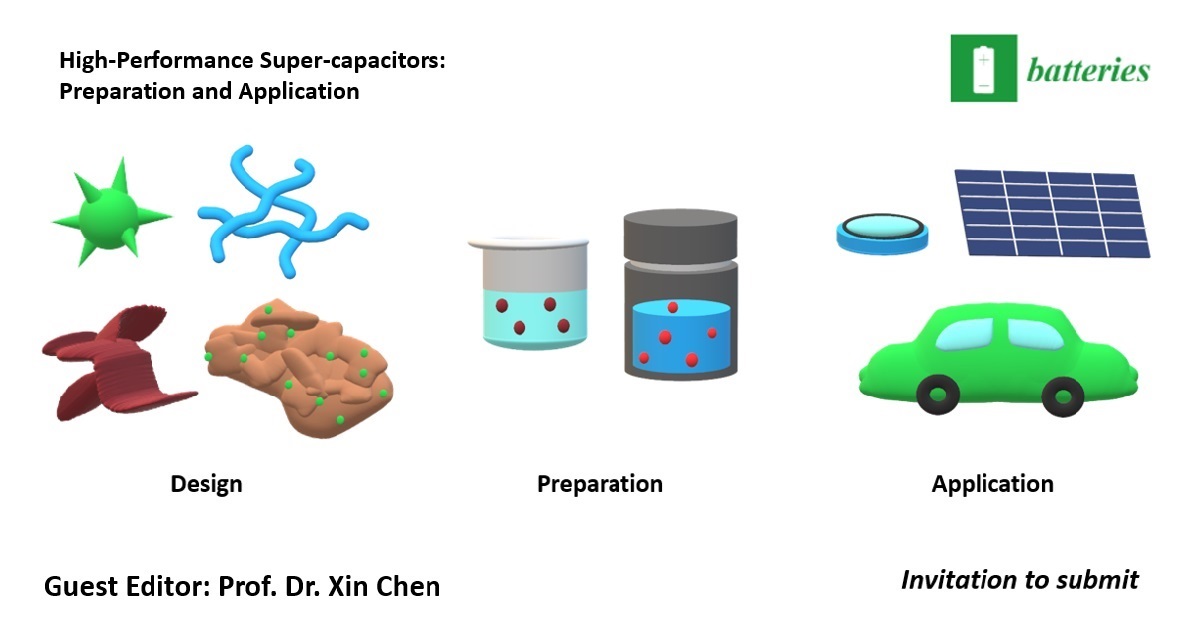- 4.8Impact Factor
- 6.6CiteScore
- 19 daysTime to First Decision
High-Performance Super-capacitors: Preparation and Application
This special issue belongs to the section “Supercapacitors“.
Special Issue Information
Dear Colleagues,
This Special Issue on high-performance supercapacitors is focused on new supercapacitor technologies. Climate change is now a global concern, and new energy materials and devices are being extensively studied to reduce greenhouse gas emissions and help solve climate change. Supercapacitor materials and devices are very promising due to their quick charge/discharge capabilities and long cycling lifetimes. What is the problem with the technology, and how can we broaden its applications?
The success of the supercapacitor technology largely depends on the improvement of the critical properties, such as the energy storage capabilities of the supercapacitor materials and devices.
In order to improve supercapacitor technology, research has been conducted to improve the energy storage capabilities of electrodes, which determine the specific capacitance of the material. Additionally, people are also working to enhance these supercapacitor devices via modeling and system development studies. What is the current status of the field, and what can we expect in the future?
This Special Issue discusses the current status and future trend of supercapacitor material and device development, which are important to enhance their performances.
Potential topics include, but are not limited to:
- Novel supercapacitor materials, positive electrode, negative electrode, and electrolytes;
- Electrode designs;
- Supercapacitor device designs;
- Electrochemical test methods;
- Modeling;
- Supercapacitor system studies.
Prof. Dr. Xin Chen
Guest Editor
Manuscript Submission Information
Manuscripts should be submitted online at www.mdpi.com by registering and logging in to this website. Once you are registered, click here to go to the submission form. Manuscripts can be submitted until the deadline. All submissions that pass pre-check are peer-reviewed. Accepted papers will be published continuously in the journal (as soon as accepted) and will be listed together on the special issue website. Research articles, review articles as well as short communications are invited. For planned papers, a title and short abstract (about 250 words) can be sent to the Editorial Office for assessment.
Submitted manuscripts should not have been published previously, nor be under consideration for publication elsewhere (except conference proceedings papers). All manuscripts are thoroughly refereed through a single-blind peer-review process. A guide for authors and other relevant information for submission of manuscripts is available on the Instructions for Authors page. Batteries is an international peer-reviewed open access monthly journal published by MDPI.
Please visit the Instructions for Authors page before submitting a manuscript. The Article Processing Charge (APC) for publication in this open access journal is 2700 CHF (Swiss Francs). Submitted papers should be well formatted and use good English. Authors may use MDPI's English editing service prior to publication or during author revisions.
Keywords
- supercapacitor
- flexible supercapacitor
- hybrid supercapacitor
- oxide
- hydroxide
- chalcogenide
- activated carbon
- carbon nanotube
- graphene
- MXene
- quantum dot
- 3D electrode
- composite electrode
- interface
- modeling
- system

Benefits of Publishing in a Special Issue
- Ease of navigation: Grouping papers by topic helps scholars navigate broad scope journals more efficiently.
- Greater discoverability: Special Issues support the reach and impact of scientific research. Articles in Special Issues are more discoverable and cited more frequently.
- Expansion of research network: Special Issues facilitate connections among authors, fostering scientific collaborations.
- External promotion: Articles in Special Issues are often promoted through the journal's social media, increasing their visibility.
- e-Book format: Special Issues with more than 10 articles can be published as dedicated e-books, ensuring wide and rapid dissemination.

